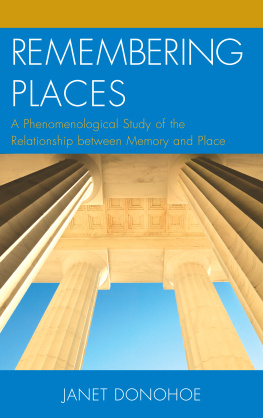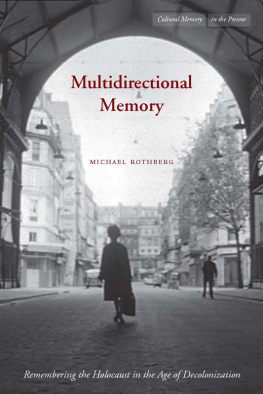Donohoe - Remembering places: a phenomenological study of the relationship between memory and place
Here you can read online Donohoe - Remembering places: a phenomenological study of the relationship between memory and place full text of the book (entire story) in english for free. Download pdf and epub, get meaning, cover and reviews about this ebook. City: Lanham, year: 2016;2012, publisher: Lexington Books, genre: Religion. Description of the work, (preface) as well as reviews are available. Best literature library LitArk.com created for fans of good reading and offers a wide selection of genres:
Romance novel
Science fiction
Adventure
Detective
Science
History
Home and family
Prose
Art
Politics
Computer
Non-fiction
Religion
Business
Children
Humor
Choose a favorite category and find really read worthwhile books. Enjoy immersion in the world of imagination, feel the emotions of the characters or learn something new for yourself, make an fascinating discovery.
Remembering places: a phenomenological study of the relationship between memory and place: summary, description and annotation
We offer to read an annotation, description, summary or preface (depends on what the author of the book "Remembering places: a phenomenological study of the relationship between memory and place" wrote himself). If you haven't found the necessary information about the book — write in the comments, we will try to find it.
Donohoe: author's other books
Who wrote Remembering places: a phenomenological study of the relationship between memory and place? Find out the surname, the name of the author of the book and a list of all author's works by series.
Remembering places: a phenomenological study of the relationship between memory and place — read online for free the complete book (whole text) full work
Below is the text of the book, divided by pages. System saving the place of the last page read, allows you to conveniently read the book "Remembering places: a phenomenological study of the relationship between memory and place" online for free, without having to search again every time where you left off. Put a bookmark, and you can go to the page where you finished reading at any time.
Font size:
Interval:
Bookmark:
Remembering Places
Toposophia: Sustainability, Dwelling, Design
Series Editors: Robert Mugerauer, University of Washington, and Gary Backhaus, Loyola
College in Maryland
Toposophia is a book series dedicated to the interdisciplinary and transdisciplinary study of place. Authors in the series attempt to engage a geographical turn in their research, emphasizing the spatial component, as well as the philosophical turn, raising questions both reflectively and critically.
Titles in the Series
Mysticism and Architecture: Wittgenstein and the Meanings of the Palais Stonborough, by Roger Paden
When France Was King of Cartography: The Patronage and Production of Maps in Early Modern France, by Christine Marie Petto
Incapacitating Biochemical Weapons: Promise or Peril?, Edited by Alan Pearson, Marie Chevrier, and Mark Wheelis
Environmental Dilemmas: Ethical Decision Making, by Robert Mugerauer and Lynne Manzo
The Timespace of Human Activity: On Performance, Society, and History as Indeterminate Teleological Events, by Theodore R. Schatzki
Metamorphoses of the Zoo: Animal Encounter after Noah, Edited by Ralph R. Acampora
Reading the Islamic City: Discursive Practices and Legal Judgment, by Akel Ismail Kahera
Spoil Island: Reading the Makeshift Archipelago, by Charlie Hailey
Remembering Places: A Phenomenological Study of the Relationship between Memory and Place, by Janet Donohoe
Remembering Places
A Phenomenological Study of
the Relationship between Memory and Place
Janet Donohoe
LEXINGTON BOOKS
Lanham Boulder New York London
Published by Lexington Books
An imprint of The Rowman & Littlefield Publishing Group, Inc.
4501 Forbes Boulevard, Suite 200, Lanham, Maryland 20706
www.rowman.com
16 Carlisle Street, London W1D 3BT, United Kingdom
Copyright 2014 by Lexington Books
All rights reserved. No part of this book may be reproduced in any form or by any electronic or mechanical means, including information storage and retrieval systems, without written permission from the publisher, except by a reviewer who may quote passages in a review.
British Library Cataloguing in Publication Information Available
Library of Congress Cataloging-in-Publication Data
Donohoe, Janet.
Remembering places : a phenomenological study of the relationship between memory and place / Janet Donohoe.
pages cm -- (Toposophia : sustainability, dwelling, design)
Includes bibliographical references and index.
ISBN 978-0-7391-8716-6 (cloth : alk. paper) -- ISBN 978-0-7391-8717-3 (electronic)
1. Memory (Philosophy) 2. Place (Philosophy) 3. Monuments--Miscellanea. 4. Phenomenology. I. Title.
BD181.7.D66 2014
128'.3--dc23
2014014813
 TM The paper used in this publication meets the minimum requirements of American National Standard for Information Sciences Permanence of Paper for Printed Library Materials, ANSI/NISO Z39.48-1992.
TM The paper used in this publication meets the minimum requirements of American National Standard for Information Sciences Permanence of Paper for Printed Library Materials, ANSI/NISO Z39.48-1992.
Printed in the United States of America
For Philip, William, and Thomas
In my experience it takes many people to write and publish a book and while I take full responsibility for everything between the covers of this book, I could not have completed it without help from others who have my deepest gratitude.
I am grateful to Steve Gish, and Ken and Bernadine Clark for the generosity of allowing me to use photographs from far flung places, and for the generosity of friendship throughout this process.
Many people provided encouragement and support over the last several years without which this project probably would have remained undeveloped. David Seamons contributions in that regard are especially appreciated. Thanks to Bob Mugerauer, editor of the series, for seeing promise in the project and to the anonymous reviewer whose careful critique made the book better.
Thanks to Jana Hodges-Kluck at Lexington Books for answering my many questions and making the process as painless as possible.
I am particularly grateful to Dennis Keenan, David Vessey, and Jeremy Wisnewski for comments and suggestions on earlier drafts of this manuscript and for the decades of intellectual companionship. What an impoverished philosophical life I would have without them. Thank you to the members of the Society for Philosophy in the Contemporary World, especially Trudy Conway, Joe Jones, and Charlie Harvey for their support and questioning of my work over the years, and for the friendship and collegial intellectual challenges.
And thanks most of all to my husband, Philip, and my two beautiful boys, William and Thomas, for their patience and willingness to put up with me while I was writing, but most of all for helping me to keep it all in perspective. You make it all worthwhile.
Parts of each chapter have been published previously and I am grateful to the editors of those publications for permission to reprint them here in altered form. They are as follows: Part of chapter 1 adapted by permission of the publishers from The Place of Home, in Environmental Philosophy, volume 8, pp. 2540. Copyright 2011. In chapter 2 parts of sections I and II adapted by permission of the publishers from Where Were You When... ? On the Relationship between Individual Memory and Collective Memory, in Philosophy in the Contemporary World, volume 16, pp. 105113. Copyright 2009. Also in chapter 2, part of section III adapted by permission of the publishers of The Place of Tradition: Heidegger and Benjamin on Technology and Art, in Journal of the British Society for Phenomenology, volume 39, pp. 260274. Copyright 2008. Part of chapter 3 adapted by permission of the publishers from Coming Home and Places of Mourning, in Resisting the Place of Belonging edited by Daniel Boscaljon (Farnham: Ashgate, 2013), pp. 171179. Copyright 2013. Chapter 4 contains versions of three different articles adapted by permission of the publishers from The Betweenness of Monuments, in Environmental Hermeneutics (New York: Fordham University Press, 2013), pp. 264280. Copyright 2013; Rushing to Memorialize, in Philosophy in the Contemporary World, volume 13, pp. 612. Copyright 2006; and Dwelling with Monuments, in Philosophy and Geography, volume 5, pp. 235242. Copyright 2002.
Memory. Tradition. Place. It took me a long time to realize that it is impossible to put these terms into any kind of hierarchical, chronological, or foundational order. In fact, the three terms are so intricately interwoven that it is difficult to separate one from the others. As Edmund Husserl might say, they are distinct, but not separate. Experience is always and everywhere an interweaving of the three. It is this complex web that I hope to be able to shed some light on in the following pages. While it is not difficult to see the connection between memory and tradition, the position of place is perhaps less obvious for place has for so long been overlooked, untheorized, and forgotten. In recent years there has been an increasing interest in place, and even in place in its connection with memory or tradition, but there is much more that can be said and I try to say some of it here.
The importance of place is hard to deny. There are good reasons we take our children and spouses to see the places where we grew up. Seeing the house, the yard, the neighborhood, or the town, and walking around and through them fulfills what would otherwise be constitutionally and narratively impoverished. Likewise, going to the gravesites of ancestors, sometimes many generations past, provides more than simply a mnemonic trigger. These places are imbued with memory and the aura of such places connects us to the past and to traditions, making them present to us.
Font size:
Interval:
Bookmark:
Similar books «Remembering places: a phenomenological study of the relationship between memory and place»
Look at similar books to Remembering places: a phenomenological study of the relationship between memory and place. We have selected literature similar in name and meaning in the hope of providing readers with more options to find new, interesting, not yet read works.
Discussion, reviews of the book Remembering places: a phenomenological study of the relationship between memory and place and just readers' own opinions. Leave your comments, write what you think about the work, its meaning or the main characters. Specify what exactly you liked and what you didn't like, and why you think so.







